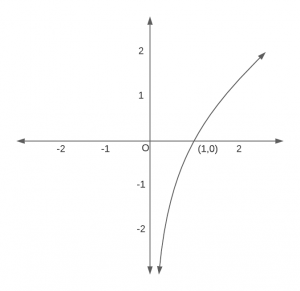Here you will learn what is logarithmic function graph, formula, domain and range.
Let’s begin –
Logarithmic Function
Definition : If a > 0 and a \(\ne\) 1, then the function defined by f(x) = \(log_a x\), x > 0 is called the logarithmic function.
We know that logarithmic function and the exponential function are inverse of each other.
i.e \(log_a x\) = y \(\iff\) x = \(a^y\)
Also Read : Types of Functions in Maths – Domain and Range
Logarithmic Function Graph
Case 1 : When a > 1,
In this case, we have
y = \(log_a x\) = \(\begin{cases} < 0, & \text{for}\ 0 < x < 1 \\ = 0, & \text{for}\ x = 1 \\ > 0, & \text{for}\ x > 1 \end{cases}\).
Also, the value of y increase with increase in x.
Thus, the graph f(x) = \(log_a x\) for a > 1 is :

Case 2 : When 0 < a < 1
In this case, we have
y = \(log_a x\) = \(\begin{cases} > 0, & \text{for}\ 0 < x < 1 \\ = 0, & \text{for}\ x = 1 \\ < 0, & \text{for}\ x > 1 \end{cases}\).
Also, the value of y decrease with the increase in x.
Thus, the graph y = \(log_a x\) for 0 < a <1 is :

Domain and Range
We observe that the domain of the logarithmic function is the set of all non-negative real numbers i.e. \((0, \infty)\) and the range is the set R of all real numbers.
Domain : \((0, \infty)\)
Range : R
